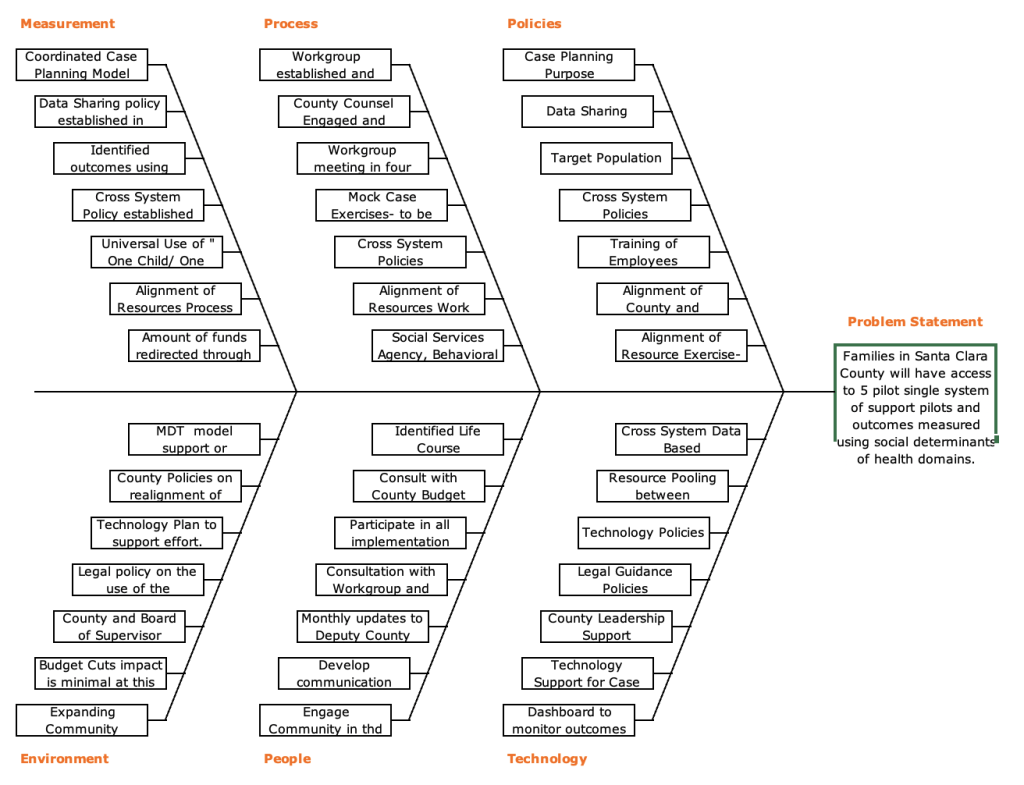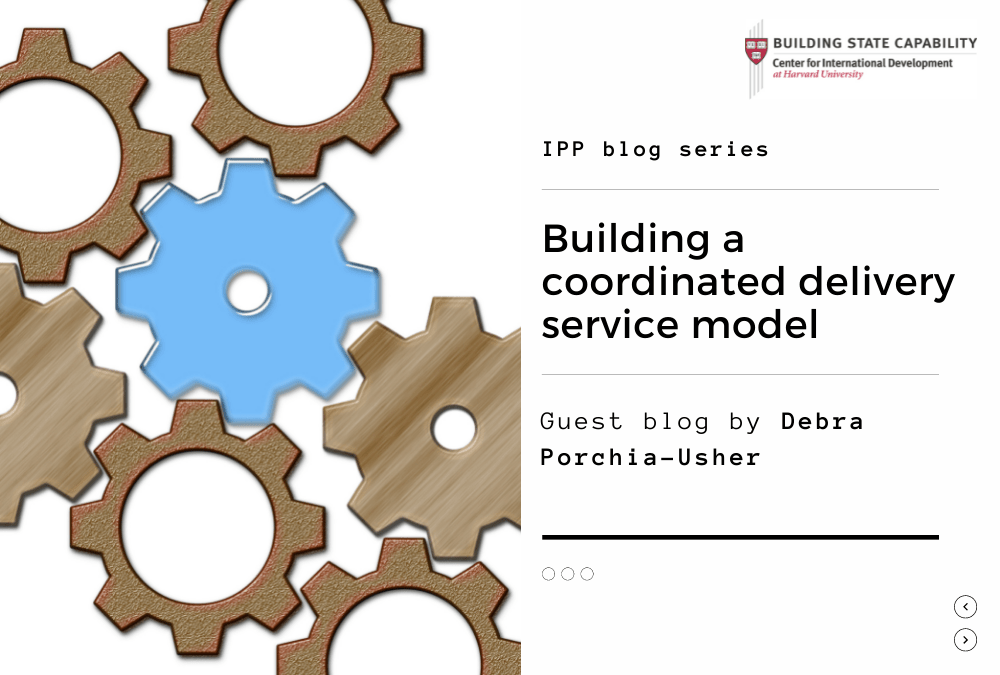Guest blog by Debra Porchia-Usher
Initial Expectations
I entered IPP Online Course with excitement and with the expectation that guidance would be provided to simplify the proposed ‘public policy challenge’ facing myself and my colleagues. The timing was great, as my colleagues and I had recently committed to the design and execution of a coordinated service delivery model of human services. The authorizing team of 12-15 human service leaders, including myself, made a firm visionary statement (“if not now, when”), affirming the commitment to get this done. I was sure that a guidebook would assist the team to develop an outline that would lead to an immediate solution. Essentially, an opportunity made simple and I believed that we, as a diverse team of providers, had all the pieces in place were for immediate action: 1) strong partnerships, 2) a common vision and goal, 3) motivated supporters, 4) County Chief Executive Office support, 5) consultant resources, 6) diverse group of champions, 7) community commitment to pilot the model in four communities and 8) a project timeline. It became very clear in the first two week of lectures and the introduction of PDIA, that our team did not have a clear understanding of the complexity of our problem, nor did we have a concise problem statement reflective of the intended goal. Early on, it also became evident that PDIA offered the Fishbone Diagram as a tool to map out the known and unknown factors. The input of the technical support and from peers on the fishbone identified additional gaps in knowledge, potential missed entry point opportunities and critical stakeholders. In addition, the diagram generated input from the larger stakeholder group which subsequently led to further clarification on the resource gaps and small win opportunities. The use of the Fishbone Diagram promoted an expanded thought process, strategic thinking about the actual problem at hand and extensive consideration of cause and effect influence within both the planning and execution of response to a complex policy challenge.
Leadership
The numerous uncertainties and possibilities that are often embedded in complex problems require an adaptive and flexible leadership style. A leader often finds themselves in a variety of roles, including that of an authorizer, champion, subject expert, team lead or individual contributor and/or periodic consultant. Most importantly the leader develops and imparts the vision for the policy challenge and can engage key stakeholders in the execution of the vision or the refinement of the vision based upon the input from stakeholders. In addition, the varying elements within a complex problem require an ability to understand the need to break the problem into doable pieces and recognize that the learning from one element informs others throughout the process. Lastly, but not any less important, is the ability of the leader to connect with his or her team throughout the process to ensure that they are on point and to assist the team to consider and integrate as appropriate any earlier learnings into the path going forward. A leader’s connection to a team(s) is a must and therefore any plan should incorporate a communication strategy that facilitates ongoing feedback between the leaders, authorizers, champions, team leads and other relevant parties to share the knowledge obtained from an individual or the larger group. Problem Driven Interactive Adaptation (PDIA) offers tools that can serve as 1) a means to gain sight on the perceptions of team members, 2) communication and learning tools for any team engaged in solving a complex issue and 3) assist in the building of internal and external capacity 4) identify immediate action steps upon which to learn and adapt current processes.
Constructing and Destructing a Problem
The Fishbone was an exercise that I often found trying but helpful. It forced me to entertain the many aspects of the chosen project. Each aspect had to be thoroughly explored and tested with varying stakeholders or outside influencers. Deconstructing the problem using the Fishbone forced me throughout its several reiterations to further break down each identified element into critical exploration and action steps. The final rendition of my problem statement took a drastic turn from one that presupposed a solution to one that more accurately reflected a desired outcome. However, in reviewing it for this blog, I still believe it requires additional work. I found sharing my initial Fishbone diagram with several co-authorizers, champions and consultants to be a means to promote communication among project team members, solicit and obtain feedback, including the gaps in knowledge and the identification of additional stakeholders who needed to be invited to the table to address gaps in knowledge and/or resources. The construction and iterative reconstruction of the problem statement and learning from initial action steps resulted in the revision of the problem statement and the prioritization of action steps that can generate quick wins and provide learning to inform the development of further action steps.
Implementation Challenge
A critical component to the success of the coordinated case management model is the ability to share data between the agencies when families are served by multiple agencies. Often families, served by multiple agencies are forced to carry out the action steps noted in multiple case plans, often with conflicting requirements. The sharing of data between the agencies would facilitate coordination of services and the development and execution of a coordinated case plan that would support family success. Since the onset of the project, there have been efforts to work with County Counsel (Legal Team) to address the inherent barriers to the sharing of data by agencies serving the same family. Little progress was made until recently return of a former County Counsel to the Social Service Agency. She is familiar and supportive and has found a couple of legal opportunities that may be viable. While it is fortunate to have a community- based partner who is willing to pilot the model in several locations, it puts pressure on the team to ensure that the case management model and supportive policies are in place prior to July 1, 2021. However, using the reiterative approach with the existing pilot and assessing its potential application to the future initiative may be the means to a timely solution and small win.
Progress and Insights
Authorizer commitment to the challenge was reiterated by a diverse composite of community leaders, a County Executive Officer, and the Board of Supervisors. A primary project authorizer committed to funding 4 pilot locations to support the coordinated service delivery model and therefore provided the planning team additional time to develop the policies, practices, and partnerships with the pilot communities. The insight gained by myself and other authorizers and champions with whom I shared the Fishbone Diagram was that primary concerns had not been identified nor were strategies to address them included in the initial plan. The data sharing and communication were immediately identified as areas needing significant work. The data sharing still requires clarity on the anticipated outcomes of this change in policy. Another significant gap area was communication. There continues to be a focus on the development of a formal communication strategy and a public relations firm has been identified to assist the team. As noted above, the team had an idea and not a clear problem statement. Having meetings with the steering committee and consultant group resulted in clarity in the problem statement and the planning process moving forward. Weekly meetings with the consultant group ensured that guidance to the several committees involved in the planning process and the use of the feedback loop is a vehicle to share learning and information and is of benefit to the planning and execution process.
Motivation and Future Approaches
The well-being of families and children most in need is my passion. I have been fortunate that I have colleagues who possess the same passion and are committed to the success of this effort. Improving service delivery and outcomes for the most vulnerable families and children is the focus of this effort and is consistent with the values of all the team members. Therefore no one individual alone is impacted by the success or failure of this effort. The legacy of this experience for me rests in three key areas 1) deconstruction of a problem, 2) construction of a problem from multiple angles and 3) communication and the value of the feedback loop and marketing strategy throughout the implementation process. In addition, the fluidity in the process due to changing circumstances, stakeholders and/or leadership provides an opportunity for reflection and learning.
Lessons Learned and Used
There are immeasurable benefits in the use of reflective thought during the visioning, engaging, and planning processes, specifically in the tackling of a complex issue. PDIA offers an exciting opportunity to engage a wide range of stakeholders, consider new knowledge, celebrate small wins and reinvigorate the plan and team members to move forward until the goal long term goal is reached or extended to other newly generated problem opportunities. I leave more excited! Thank you, Dr. Andrews, and IPP Team.

This is a blog series written by the alumni of the Implementing Public Policy Executive Education Program at the Harvard Kennedy School. Participants successfully completed this 6-month online learning course in December 2020. These are their learning journey stories.
